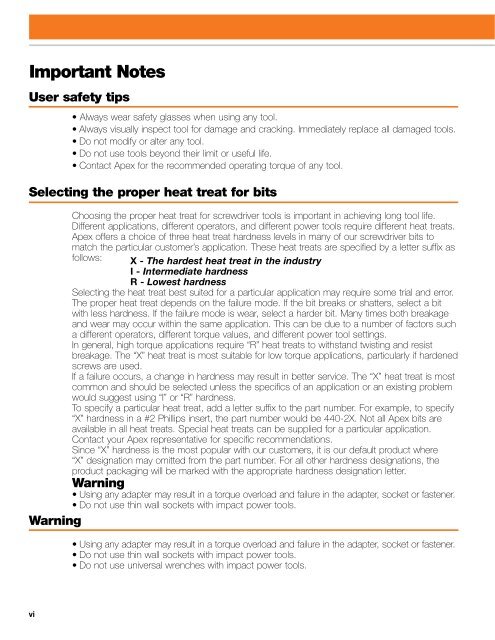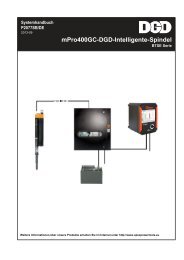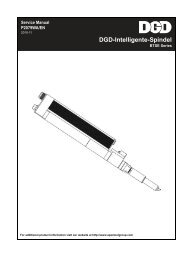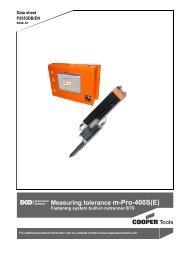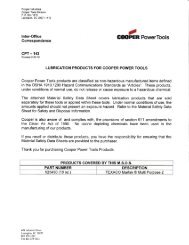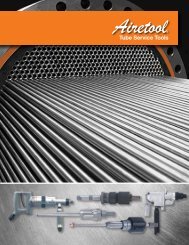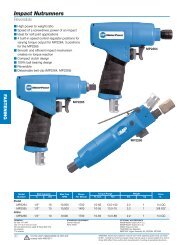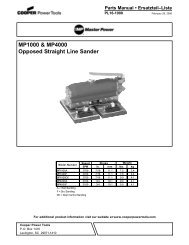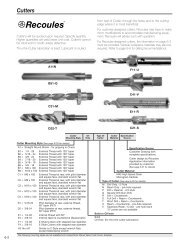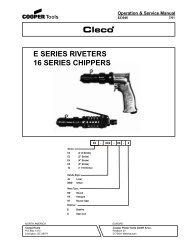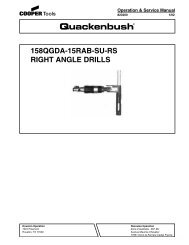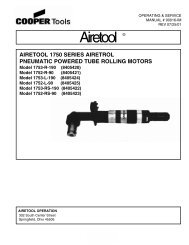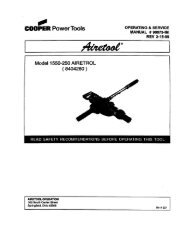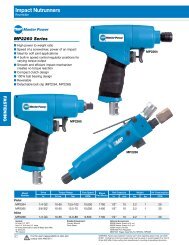Industrial Fastener Tools - Apex Tool Group
Industrial Fastener Tools - Apex Tool Group
Industrial Fastener Tools - Apex Tool Group
You also want an ePaper? Increase the reach of your titles
YUMPU automatically turns print PDFs into web optimized ePapers that Google loves.
Important Notes<br />
User safety tips<br />
Selecting the proper heat treat for bits<br />
Warning<br />
vi<br />
• Always wear safety glasses when using any tool.<br />
• Always visually inspect tool for damage and cracking. Immediately replace all damaged tools.<br />
• Do not modify or alter any tool.<br />
• Do not use tools beyond their limit or useful life.<br />
• Contact <strong>Apex</strong> for the recommended operating torque of any tool.<br />
Choosing the proper heat treat for screwdriver tools is important in achieving long tool life.<br />
Different applications, different operators, and different power tools require different heat treats.<br />
<strong>Apex</strong> offers a choice of three heat treat hardness levels in many of our screwdriver bits to<br />
match the particular customer’s application. These heat treats are specified by a letter suffix as<br />
follows:<br />
X - The hardest heat treat in the industry<br />
I - Intermediate hardness<br />
R - Lowest hardness<br />
Selecting the heat treat best suited for a particular application may require some trial and error.<br />
The proper heat treat depends on the failure mode. If the bit breaks or shatters, select a bit<br />
with less hardness. If the failure mode is wear, select a harder bit. Many times both breakage<br />
and wear may occur within the same application. This can be due to a number of factors such<br />
a different operators, different torque values, and different power tool settings.<br />
In general, high torque applications require “R” heat treats to withstand twisting and resist<br />
breakage. The “X” heat treat is most suitable for low torque applications, particularly if hardened<br />
screws are used.<br />
If a failure occurs, a change in hardness may result in better service. The “X” heat treat is most<br />
common and should be selected unless the specifics of an application or an existing problem<br />
would suggest using “I” or “R” hardness.<br />
To specify a particular heat treat, add a letter suffix to the part number. For example, to specify<br />
“X” hardness in a #2 Phillips insert, the part number would be 440-2X. Not all <strong>Apex</strong> bits are<br />
available in all heat treats. Special heat treats can be supplied for a particular application.<br />
Contact your <strong>Apex</strong> representative for specific recommendations.<br />
Since “X” hardness is the most popular with our customers, it is our default product where<br />
“X” designation may omitted from the part number. For all other hardness designations, the<br />
product packaging will be marked with the appropriate hardness designation letter.<br />
Warning<br />
• Using any adapter may result in a torque overload and failure in the adapter, socket or fastener.<br />
• Do not use thin wall sockets with impact power tools.<br />
• Using any adapter may result in a torque overload and failure in the adapter, socket or fastener.<br />
• Do not use thin wall sockets with impact power tools.<br />
• Do not use universal wrenches with impact power tools.


